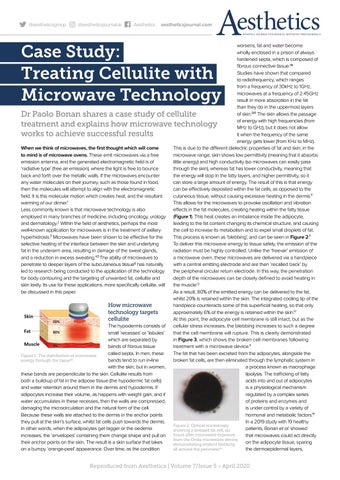@aestheticsgroup
@aestheticsjournaluk
Aesthetics
aestheticsjournal.com
Case Study: Treating Cellulite with Microwave Technology
worsens, fat and water become wholly enclosed in a prison of always hardened septa, which is composed of fibrous connective tissue.7,8 Studies have shown that compared to radiofrequency, which ranges from a frequency of 30kHz to 1GHz, microwaves at a frequency of 2.45GHz result in more absorption in the fat than they do in the uppermost layers of skin.9,10 The skin allows the passage Dr Paolo Bonan shares a case study of cellulite of energy with high frequencies (from treatment and explains how microwave technology MHz to GHz), but it does not allow works to achieve successful results it when the frequency of the same energy gets lower (from KHz to MHz). When we think of microwaves, the first thought which will come This is due to the different dielectric properties of fat and skin; in the to mind is of microwave ovens. These emit microwaves via a free microwave range, skin shows low permittivity (meaning that it absorbs emission antenna, and the generated electromagnetic field is of little energy) and high conductivity (so microwaves can easily pass ‘radiative type’ (free air emission), where the light is free to bounce through the skin), whereas fat has lower conductivity, meaning that back and forth over the metallic walls. If the microwaves encounter the energy will stop in the fatty layers, and higher permittivity, so it any water molecules on their journey, such as those found in food, can store a large amount of energy. The result of this is that energy then the molecules will attempt to align with the electromagnetic can be effectively deposited within the fat cells, as opposed to the field. It is this molecular motion which creates heat, and the resultant cutaneous tissue, without causing excessive heating in the dermis.11 1 warming of our dinner. This allows for the microwaves to provoke oscillation and vibration Less commonly known is that microwave technology is also effects in the fat molecules, creating heating within the fatty tissue employed in many branches of medicine, including oncology, urology (Figure 1). This heat creates an imbalance inside the adipocyte, and dermatology.2 Within the field of aesthetics, perhaps the most leading to the fat content changing its chemical structure, and causing well-known application for microwaves is in the treatment of axillary the cell to increase its metabolism and to expel small droplets of fat. hyperhidrosis.3 Microwaves have been shown to be effective for the This process is known as ‘blebbing’, and can be seen in Figure 2.11 selective heating of the interface between the skin and underlying To deliver this microwave energy to tissue safely, the emission of the fat in the underarm area, resulting in damage of the sweat glands, radiation must be highly controlled. Unlike the ‘free-air’ emission of and a reduction in excess sweating.4,5 The ability of microwaves to a microwave oven, these microwaves are delivered via a handpiece penetrate to deeper layers of the subcutaneous tissue6 has naturally with a central emitting electrode and are then ‘recalled back’ by led to research being conducted to the application of the technology the peripheral circular return electrode. In this way, the penetration for body contouring and the targeting of unwanted fat, cellulite and depth of the microwaves can be closely defined to avoid heating in skin laxity. Its use for these applications, more specifically cellulite, will the muscle.12 be discussed in this paper. As a result, 80% of the emitted energy can be delivered to the fat, whilst 20% is retained within the skin. The integrated cooling tip of the How microwave handpiece counteracts some of this superficial heating, so that only technology targets approximately 6% of the energy is retained within the skin.12 cellulite At this point, the adipocyte cell membrane is still intact, but as the The hypodermis consists of cellular stress increases, the blebbing increases to such a degree small ‘recesses’ or ‘lobules’ that the cell membrane will rupture. This is clearly demonstrated which are separated by in Figure 3, which shows the broken cell membranes following bands of fibrous tissue treatment with a microwave device.11 called septa. In men, these The fat that has been excreted from the adipocytes, alongside the Figure 1: The distribution of microwave bands tend to run in-line broken fat cells, are then eliminated through the lymphatic system in energy through the tissue13 with the skin, but in women, a process known as macrophage these bands are perpendicular to the skin. Cellulite results from lipolysis. The trafficking of fatty both a build-up of fat in the adipose tissue (the hypodermic fat cells) acids into and out of adipocytes and water retention around them in the dermis and hypodermis. If is a physiological mechanism adipocytes increase their volume, as happens with weight gain, and if regulated by a complex series water accumulates in these recesses, then the walls are compressed, of proteins and enzymes and damaging the microcirculation and the natural form of the cell. is under control by a variety of Because these walls are attached to the dermis in the anchor points hormonal and metabolic factors.14 they pull at the skin’s surface, whilst fat cells push towards the dermis. In a 2019 study with 19 healthy Figure 2: Optical microscopy In other words, when the adipocytes get bigger or the oedema patients, Bonan et al. showed showing a stressed fat cell, six increases, the ‘envelopes’ containing them change shape and pull on hours after microwave exposure that microwaves could act directly from the Onda microwave device, their anchor points on the skin. The result is a skin surface that takes on the adipocyte tissue, sparing demonstrating evident blebbing on a bumpy ‘orange-peel’ appearance. Over time, as the condition all around the perimeter11 the dermoepidermal layers,
Reproduced from Aesthetics | Volume 7/Issue 5 - April 2020


















